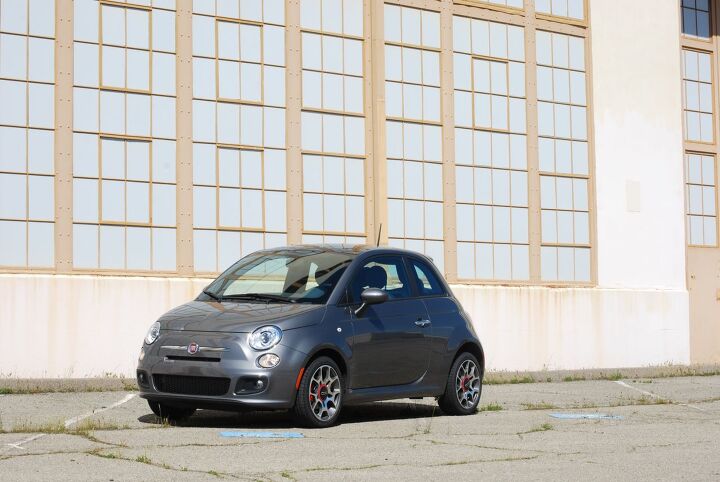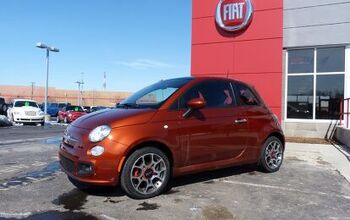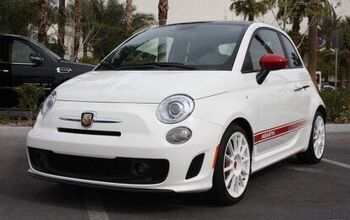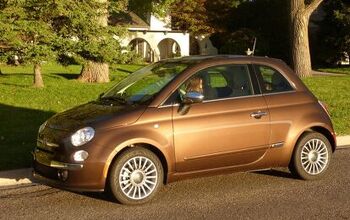Review: 2012 Fiat 500 Sport

I’ve been waiting 28 years for Fiat to return to the United States, and that means TTAC is going back-to-back on the Fiat 500 coverage, following up Michael Karesh’s review with one of my own.
Me and Fiat, we have a history, see. My parents, already owners of a new Chevrolet Beauville passenger van, bought a pair of new Fiat 128 sedans in 1973. One was pungent green, the other a sort of washed-out yellow, and I knew in my 7-year-old heart that those cars made the best engine noises ever. You had to rev the piss out of that 62-horsepower engine to make the 128 go anywhere, but my mom grew up driving an ice-racing-prepped Porsche 356-engined Beetle and she went for the redline with each shift.
Those 128s crumbled into decrepitude fast, even by the lax standards of the time— my parents stuck with the yellow one for two years and the green one for three before washing their hands of the little Italian machines— but this was a four-door car that sold for $2,299, exactly the list price of the even more miserable and primitive ’73 VW Beetle (do we need to discuss the $2,306 ’73 Datsun 510? I think not). Regardless of the inherent terribleness of the 128 (with its switches that broke off under your fingers, doors that wouldn’t stay latched, and sheetmetal that managed to rust even in Northern California) the racy sound of that Fiat SOHC, more than anything else I recall from my childhood, turned me into a car freak.
Fiat’s fortunes in the United States went straight to hell starting in the late 1970s, as Fiat sales got slugged by relentless competition from cheap and reliable Japanese subcompacts and sports cars, while its “Fix It Again, Tony” brand image among American car shoppers was making the Greco-Italian War look sensible by comparison. Americans recoiled in horror from the new Strada, and Fiat retreated from the continent after the 1983 model year. As a cruel reminder of Fiat’s American glory days, the 124 Sport Spider lurched along, zombie-style, under the Pininfarina banner until 1985, while virtually unsellable Bertone-badged X1/9s were imported by past Subaru and future Yugo mastermind Malcolm Bricklin until 1987.
Yes, that’s Dennis Farina cold blasting a Smith & Wesson-packing California heavy who sneers at his Beretta: “The Fiat of guns. Always jamming on you!” Generations of Americans thought of Fiat as a joke, in spite of the company’s big sales elsewhere in the world, and even those too young to remember being stranded at the side of the road in an overheating Brava have heard the jokes from their elders. Truly, a return of Fiat to the United States could only happen under unusual circumstances, and the first Fiat-badged machine to hit our shores would need to be something special.
Well, the special circumstances are here (who in the hell could have predicted the Fiat-Chrysler deal?) and the 2012 Fiat 500 differs as much from the decline-and-fall models of the 1970s as the 2012 Corolla differs from its wonky, rattly-ass 1970s ancestors. I had a 500 Sport for nearly a week when I visited California to serve in the LeMons Supreme Court at the Sears Pointless 24 Hours of LeMons, and I had the chance to beat on it in the real world of San Francisco Bay Area wet-weather driving as well as the not-so-real world of a LeMons paddock.
Let’s start with the looks of the new 500. Even among Americans old enough to remember new Fiats on the street, the profile of the original 500 is nowhere near as iconic as it is to Europeans. The original 500 sold about as well in the US of A as the Renault Dauphine; i.e., hardly at all. That means that Fiat can’t cash in on a beloved retro image along the lines of the Beetle or Mustang, but it also means that there won’t be much groaning about the new 500 scaling in at over twice the curb weight of the original.
Let’s face it, Americans associate tiny European cars of the postwar era with pessimism. Underemployment. Diminished expectations. American car buyers of the 1950s and 1960s laughed at these cars, though they were actually pretty impressive engineering accomplishments.
The new 500 Sport, however, may appear more Japanese than Italian to American eyes. Note the similarity of profile to the Yaris; sure, some echoes of the cinquecento come through, but you get a lot more Yaris (and Fit) at first glance. Could Chrysler/Fiat have gotten away with bringing in a cheaper, sported-up version of the Panda for its American invasion? I thought so… until I brought the thing to Infineon Raceway.
LeMons racers, many of whom tend to be super-geeked-out automotive obsessives with garages full of Panhards and Sunbeams, went apeshit over the sight of the 2012 500 in the Infineon pits. I figured this Fiat 124 Sport Spider racer would be very happy to pose his car next to the Judgemobile in the Penalty Box after his black flag, and such turned out to be the case. Note the size of the 2012 Fiat relative to the 1977 Fiat.
Still, the juxtaposition of old and new Fiat highlights the reduced “Italian-ness” of the newer car’s appearance. The 124 Spider was, by any but the most delusional standards, a punitively awful machine, down there in the build-quality mud with the comprehensively bad Triumph Spitfire, but it looked cool!. The new 500 looks cool, too, but the only strong reaction I got with mine outside of Infineon was from the gearhead kid in the Bondo-and-primer Alfa Milano who nearly plowed into a bus stop while rubbernecking at the Fiat. For the most part, the 500 just blended in.
Still, I kept posing the 500 with various Italian classics at the track, hoping I’d spot the spiritual link. Was it there? I couldn’t see it, but the car definitely grabbed the attention of hopeless car nerds knowledgeable automotive enthusiasts in this context. Everywhere the 500 went at Infineon, LeMons racers would drop their tools, mid-engine-swap, to check out the new Fiat. This meant that I had the opportunity to make humans of all sizes try to fit in the front and rear seats. A 6′ 4″ Alfa Romeo driver fit fairly well in the front of the sunroof-equipped 500; without the sunroof, a taller driver should fit just fine. Folks up to 5′ 8″ had sufficient room in the back seat, and TTAC Editor-In-Chief Ed Niedermeyer managed to ride 50 miles with his 6-foot frame squeezed into the back; he wasn’t comfortable, but it worked.
Here’s Judge Jonny at the wheel of the Sears Pointless 24 Hours of LeMons Semi-Official Pace Car. Mr. Lieberman liked the tip-in of the 500 and was pleased to lead the parade of 173 heaps around the famed track.
Back in the real, i.e. non-LeMons world, I still thought the 500 looked pretty good in spite of its lack of look-at-that passerby-grabbing magnetism. The Sport wheels have a quasi-custom appearance, without crossing the line into Manny, Moe, and Jack-grade cheeze, and the 195/45-16 tires look good and meaty on such a small car.
The interior of the 500 is made of unapologetically cheap materials, with none of the mock-classy “chrome”-plated plastic or Simu-Wood™ trim so beloved by Detroit in years past. Had the Chrysler of ten years ago had anything to do with this car, I feel certain its interior would have been spackled over with as much greasy, casting-flash-laden plastic as the lowest of low-bidder Indonesian petrochemical companies could have pumped into tanker vessels. Today, as Ice-T would say, shit ain’t like that. This is a cheap small car, and it’s not being marketed as a consolation prize for losers who couldn’t afford a new Chrysler Concorde; it’s made for buyers who want a little gas-sipping commuter with something of a sporty edge.
Nothing very exciting to report on the controls and instrumentation; this is all bland and reasonably well-placed gear. I poked around a bit under the dash and found that the quality of switches and electrical connectors looked fairly decent. I can’t make any promises based on my short acquaintance with the car, but it appears that the dash controls should hold together much longer than their counterparts from the Bad Old Days of Fiat.
The body-color plastic dash insert added a touch of motorcycle-fuel-tank-style snazz to the interior, and it should be easy to clean when passengers experience fast-food mishaps (or worse). I’m skeptical about its ability to maintain its color after a few years of sun in Albuquerque or San Diego, but who cares? It’s a cheap small car!
It’s just refreshing to see such lack of pretense in a car interior’s surfaces these days, even in a subcompact. You put this stuff through an American focus group and they’ll always demand heraldic crests and gingerbread, so it’s good to see that Fiat and Chrysler ditched that nonsense for the USDM 500.
Look at this: no attempt made to camouflage the seat-mounting hardware! Just about all cars at the low end of the price spectrum for the last 20 years have had a crappy hunk of plastic that snaps over the ends of the seat-track brackets, where it spends several years collecting nasty schmutz and developing cracks, before working loose and generally making the car owner feel that this machine is disintegrating. Not so on the 500, which doesn’t fear showing the occasional bolt head. It’s a small thing, but I find it illustrative.
The Bose Premium Audio system that comes with the Sport package fills up the 500’s little cabin with brain-scrambling volume, thumping out bass quality that would impress Tigra and Bunny; I found that Mike Jones’ Still Tippin’ sounded incredibly good when cranked way, way up. Pantera wasn’t quite as impressive, so it appears that the system was engineered with hip-hop rather than metal in mind (though I’m sure that enough twiddling with the somewhat frustrating audio controls could have done justice to Dimebag Darrell’s sound).
Speaking of frustration, I had a tough time reading the tachometer at a glance; it appears that Fiat took a look at the instrument budget and went all-out for style over function. The tach needle is tiny and hard to see, and seems to fall behind engine reality at times. I found myself hitting the rev limiter when the tach indicated I still had 500 RPM to go. Not a big deal, since it’s the sort of thing a driver adjusts for after a few weeks in the car, and understandable given the low cost of the car… but this is one area I’d prefer straight-up function.
And, now that we’ve veered off into curmudgeonly complaints, I hope that Fiat’s enforcers pour some castor oil down the throats of their owner’s-manual tech writers. Take a look at the callout numbers in the manual…
…and now check out the corresponding entries for those items. See how they don’t match up? I’m a technical writer by trade, and it causes me physical pain to see something this easy get screwed up. If your organization misses this stuff, what else has it missed? However, I suspect that this is just a localization glitch, caused by a hurried Americanization of the UK-market 500 manual, and that the 500s rolling out of the showrooms will have more usable manuals.
Returning to the 500’s interior, we see the no-frills seat fabric in action here. Cheap stuff, not pretending to look expensive. It ought to hold up under the rigors of real-world use pretty well, given that it isn’t weakened by pleather piping, fake buttons, or embossing.
The only thing I really disliked about the interior was the headrest design. The headrests are hard, unforgiving plastic with a tortilla-thin layer of padding. If you tend to sprawl out lowrider-style with your head against the headrest while driving, as I do, you’ll find your dome gets quite a beating when going over road irregularities. I’m sure there’s cheap aftermarket padded covers available, preferably something suitably blinged-out, so it’s not a dealbreaker by any means.
As you’d expect in such a small car, cargo space is somewhat limited. I found that my big suitcase with my helmet and racing suit had to ride in the back seat; the seat backs fold down, but don’t manage to get fully horizontal. Most of the interior space goes to the passengers, not cargo.
USB and auxiliary audio jacks in the glovebox allow the use of portable music devices through the 500’s sound system. The interface isn’t particularly intuitive (forget about browsing your iPod through the USB-connected stereo and hoping to find a particular song), but you can play your music.
Before we start talking about driving the 500, I feel the need to point out my disappointment that the Fiat 500 by Gucci isn’t available in the United States. Sure, we’re getting the Abarth, but the country that loved the Cartier Continentals and Oleg Cassini Matadors deserves a Gucci Fiat!
First of all, I was impressed by the 500’s composure on potholed, flooded, washboardy roads in bad weather conditions. While touring the junkyards of the East Bay ( where I found this ’52 Buick Super), I subjected the 500 to the decaying infrastructure of East Oakland.
It doesn’t insulate you from the bumps like you’re Frank Sinatra floating in an Imperial with a French 75 in your hand, but it sure as hell doesn’t jar your cerebellum loose from its moorings when you discover that little puddle is really a foot-deep pit. You feel and hear the rough roads through just enough insulation to keep from being beaten up, and there’s never a sense that you’re about to be hurled into the weeds.
Heavy rain on the dreaded Nimitz Freeway? No problem. The 500 rolls right along on the highway with as little drama as cars twice its bulk. While I had the 500, I traveled hundreds of miles of highway in wet and dry road conditions, and the car proved to be a pleasant highway cruiser. Noise levels aren’t bad— you can carry on a conversation in a normal speaking voice at 80 MPH— and the car copes with Nimitz-style roughness without wearing out the driver.
The 101-horse MultiAir engine… well, it’s an engine. Somehow the 101 horsepower in the 2,350-pound 500 feels much less powerful than the 102 horsepower in my 2,200-pound ’92 Civic. I must admit I was hoping for an experience akin to what I recall from the ’73 128 of my childhood, an engine that snarls, making 101 horses feel like 202. Instead, the 1.4 MultiAir is just an unobtrusive, sensible powerplant. Would I be disappointed in a Toyota or Hyundai subcompact with an engine like this? Not at all. I just wanted something more… Italian.
The chrome-cueball gearshift knob looks jaunty, but the shifter itself has an irritatingly vague, indistinct feel. There was something familiar about its short-throw-yet-rubbery sensation, and I sifted my memory banks for days before it hit me: it feels like the shifter in the early VW Vanagon. I stalled the car a few times when mistakenly starting out in third gear, and I lived in fear of hitting second instead of fourth when downshifting from fifth (in fact, this never happened). I wouldn’t class this as a severe problem, because you’d get used to the funky shifter in the same way Fiat drivers of old got used to a headlight switch that had to be punched several times with the heel of one’s hand before the lights would come on. Were I to buy a 500, however, I’d look to the aftermarket for an improved shifter.
For the first few days I had the 500, all my driving was either stop-and-go urban, long-haul highway, or slow cruising around the Infineon Raceway grounds with all the windows down and “Funkytown” blasting. The car seemed like a good value, something I could be happy with as a long-term daily driver, but nothing about it really seemed exceptional. I managed to get 32.7 indicated miles per gallon in a mix of highway and stop/go driving, which seems respectable for a car that doesn’t compromise much on comfort, but I wasn’t quite blown away by the fuel economy. “You need to put it in Sport mode and take it on some twisty roads,” Lieberman kept telling me. With that vanilla engine, I figured, how much fun could it be?
As I discovered once I took the 500 for a couple of runs over the Oakland Hills on Fish Ranch Road after the race, the 500 Sport is plenty fun once you get it alone on a snaky, hilly road. You still don’t get much zip from the engine, but the 500’s grip on the pavement borders on ridiculous for a gas-sipping urban commuter. Sneakers-stuck-to-melting-asphalt sort of grip. Angry-cat-digging-claws-into-your-groin grip. I wasn’t talented brave enough to try to find the car’s handling limits, at least not on a public road still wet from a week of rain, but I did start to wonder what the ideal purpose for such a setup would be. A driver looking for a bomb to go screaming around the hills is going to shop for something with more engine, but a 9-to-5 commuter doesn’t need that racy suspension.
Then, while making a burrito run later in the day, I grasped the genius of the 500 Sport’s designers. This car was designed to steal parking spaces in hostile urban environments. Picture this: you’re running late for an appointment in some nightmarishly parking-challenged place like San Francisco or Manhattan. You drive around block after block, trying to spot the telltale signs of a pedestrian who will duck into a car and free up a space for you. Dozens of other drivers do the same, as all of you circle sharklike, sniffing for blood in the water.
Then you see it! An oil-burning Jetta with a space-saver spare on the left front and a 350-pound junkie at the wheel is wheezing out of a spot up ahead… but it’s on the wrong side of the street and another shark heading toward you has locked onto this tempting prey. That’s when the 500 Sport comes into its element! You whip the Fiat into a full-throttle U-turn— tires glommed to the asphalt like a crackhead on a dropped $20 bill— as the car pivots like a forklift through its tiny turning radius, and you’re into that damn parking space before your competition can even hit the turn signal. You look so cool doing it that the other driver forgets to shoot you, and you make your appointment. That’s what the 500 Sport is for.
So the 500 comes off as a great-handling, semi-fuel-stingy commuter with a good helping of fancy flourishes and retro lines that will likely be lost on Americans with sub-encyclopedic car knowledge. Build quality seems many, many orders of magnitude better than the Fiats of a generation ago. The price? As tested, $19,000. A grand of that was for the sunroof and the automatic HVAC system, but even without those not-quite-essential options, the 500 Sport costs a bit more than a Honda Fit sport hatchback and a few grand more than the Mazda 2 and Toyota Yaris. Things get even more interesting when the Scion IQ hits the showrooms. Would I buy a 500? Maybe… but I’d want to visit the Mazda showroom first.

Murilee Martin is the pen name of Phil Greden, a writer who has lived in Minnesota, California, Georgia and (now) Colorado. He has toiled at copywriting, technical writing, junkmail writing, fiction writing and now automotive writing. He has owned many terrible vehicles and some good ones. He spends a great deal of time in self-service junkyards. These days, he writes for publications including Autoweek, Autoblog, Hagerty, The Truth About Cars and Capital One.
More by Murilee Martin
Latest Car Reviews
Read moreLatest Product Reviews
Read moreRecent Comments
- Kwik_Shift_Pro4X Where's the mpg?
- Grg These days, it is not only EVs that could be more affordable. All cars are becoming less affordable.When you look at the complexity of ICE cars vs EVs, you cannot help. but wonder if affordability will flip to EVs?
- Varezhka Maybe the volume was not big enough to really matter anyways, but losing a “passenger car” for a mostly “light truck” line-up should help Subaru with their CAFE numbers too.
- Varezhka For this category my car of choice would be the CX-50. But between the two cars listed I’d select the RAV4 over CR-V. I’ve always preferred NA over small turbos and for hybrids THS’ longer history shows in its refinement.
- AZFelix I would suggest a variation on the 'fcuk, marry, kill' game using 'track, buy, lease' with three similar automotive selections.







































































































Comments
Join the conversation
I find it strange Fiat was to bring their "fuel efficent" techonology to Chrysler. The automatic's mileage of 27/34 is not that great for a car this size. The 5-speed manual is better at least. But if Hyundai can get 30/40 out of bigger cars, I find this lousy. I am sure some poeople that find this car a novelty will buy it anyway. For others, the reason to buy a tiny car is for exceptional mileage and this it does not get. Another big negative, Fiat's site says premium fuel. That Hyuandai Elantra is looking better and better but it doesn't have the charm of the 500, I will give you that.
Important Warning. I am the owner of Fiat 500 Prima Edizione # 211. This is just to let you know how terribly disappointed I am with the low quality of the FIAT 500 and terrible service of FIAT USA. I cannot even sell the darn piece of junk, because they will not fix it despite being under warranty. I have been waiting for nearly 6 months for a replacement of part which was defective from the very first day (the passenger seat!) and, after 4 visits to the FIAT OF MANHATTAN dealer, they have been unable to repair it. Total incompetence and lack of proper service.